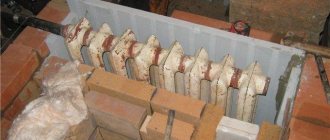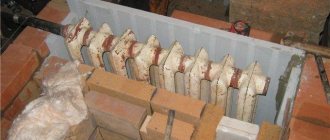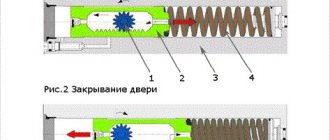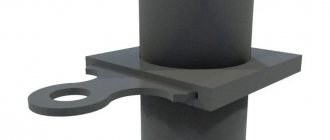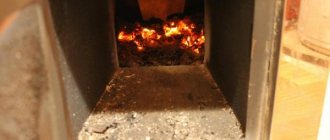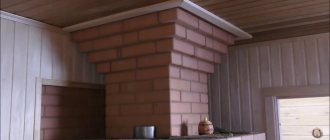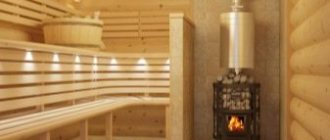Most owners of country houses and summer cottages prefer to install their own heating system by building fireplaces and stoves. This, of course, requires certain experience, knowledge and understanding of construction technology.
Gate valve - photo
One of the necessary elements for a stove to ensure its efficient operation is a chimney gate valve. In this article we will try to explain to you the principle of its operation and the step-by-step process of creating and installing it yourself.
Today, a stylish fireplace or an exclusive stove is no longer a luxury item and, if desired, you can build it yourself. In this article we will describe in detail what a chimney gate valve is, its main purpose and installation features.
Why do you need a valve?
Using a damper allows you to close the chimney channel after using the stove.
The holes in this device prevent complete blockage of the cross-section of the smoke exhaust channel. It is worth remembering that the closed position of such a valve indicates that the chimney is not in use, and the open position means the start of the firebox. The draft in the chimney is a very important indicator that determines not only the efficiency of removing combustion products from the chimney, but also the efficiency of the heating system as a whole. Therefore, traction control, carried out using a slide element, is very important. If the level of thrust in the system exceeds the permissible parameters, it is necessary to adjust the position of the gate element. This valve regulates draft by decreasing or increasing the cross-sectional area of the smoke exhaust channel.
In addition, the gate elements perform another important function, which is to regulate the combustion of products in the heating device. The intensity of combustion is controlled due to the fact that such an element regulates the movement of air flow within the system. It is worth noting that gate products cannot be installed if heating raw materials are processed in the device due to supply air flows.
The most durable and easiest to maintain are stainless or galvanized valves.
As a rule, such products are made of stainless steel, which has good strength characteristics. Stainless steel is resistant to destructive corrosive effects, and is also resistant to active chemical compounds formed inside the chimney. The thickness of the gate varies from 0.5 to 1 mm. The gates have high thermal stability and can withstand temperatures up to 900 degrees Celsius.
Helpful information! It is recommended to select dampers with a polished surface. A polished damper is easier to use and easier to clean from soot.
The damper has rolling seams and is capable of covering a fairly large area of the smoke exhaust channel (up to 85 percent). Such characteristics have made this product very popular among consumers.
Which material is stronger
In addition to structural differences, gate valves differ based on the material used at the manufacturing stage. The only available solution is stainless steel. This is due to the fact that it does not deform under the influence of high temperatures, and also retains its original appearance and characteristics even after several years of active use.
Valves in stainless steel gate valves from the manufacturer Ferrum are fixed using argon welding on a rod 8 millimeters long. The presence of a reinforced spring ensures the design's reliability and durability.
Kinds
Despite the simplicity of the design, there are different valves. The design, material and dimensions of furnace valves play a role.
By design
- Retractable. This type of plug is the most convenient. It is a chimney nozzle with a retractable plate in the middle. It is this plate that moves freely in the grooves of the chimney. This type of damper is most often used in brick stoves. But it can be installed on others. This design is easy to install and does not require installation costs.
This valve is used in brick kilns
- A rotary (throttle) gate is a type of valve where a guide is welded in the center to a metal plate. The end of this guide is on the outside and makes it possible to control the damper. By rotating the same plate along the axis, you adjust the draft in the furnace. The design is not as reliable as in the case of a retractable gate, but it has the right to life. Butterfly dampers are mainly used for steel chimneys. The rotary valve is slightly inferior to the sliding valve, but is also confidently popular.
By material
The material from which the gate is made is also very important. Each has its own nuances. There are cast iron and steel plugs.
- Cast iron provides an incredibly durable and stable appliance. It is common for furnace valves. The only significant drawback is its impressive weight. Thus, installing the valve in the furnace can become a problematic part and the installation will take more time.
- Stainless steel is lightweight, but also durable. She is not afraid of corrosion. With high-quality polishing it can last for a very long time. Just clean it, under the same conditions. Steel dampers are made of absolutely any design and are used for different types of stoves. Stainless steel began to be used quite recently, like cast iron. Maybe there is some modernity and perspective in this. Which one is up to you to decide. The main thing is to understand what is best for your stove.
Draft regulator for solid fuel boilers: selection and installation
Why do you need a draft regulator for solid fuel boilers and how to install it?
Solid fuel boilers, unlike devices using other types of fuel, are more difficult to control because they are highly inert. This may result in excess heat being generated. To regulate the intensity of fuel combustion, a draft regulator is used.
Operating principle of the draft regulator
The mechanical draft regulator operates on the principle of thermomechanics and does not require a power supply. This allows it to be used in energy-independent heating systems using solid fuel boilers.
It maintains the set coolant temperature by changing the position of the damper, which supplies air to the combustion chamber. With limited oxygen supply, combustion intensity decreases and excess heat is not released.
This eliminates overheating of structural elements, which allows you to increase the service life of the boiler. If the temperature in the pipeline needs to be raised, the damper opens slightly, increasing the access of oxygen to the flame. The draft regulator consists of the following elements:
- frame;
- lever arm;
- immersion sleeve;
- plastic handle with scale;
- thermocouple;
- steel chain.
The working material in the thermostat expands or contracts when the coolant in the boiler heats up and cools down. Changing its size affects the lever, which changes its position. As a result, the damper opens or closes.
Advice! The disadvantage of solid fuel boilers is their short combustion time. By loading a portion of fuel, you can ensure the operation of the heat generator for 3-4 hours. To extend the burning time, you need to reduce the air flow into the firebox. This can be achieved using a draft regulator.
Device installation
The draft regulator can be installed vertically or horizontally on the boiler. It depends on where the hole is provided for its installation. Installation is easy and quick:
- If installed horizontally, the fixing screw must be in the up position.
- If vertical installation is intended, the fixing screw should be on the rear side.
- When you take the draft regulator out of the package, you will find that the lever has been removed. This is usually done to make the packaging smaller. The lever must be secured with a locking screw in a suitable position so that the screw is on the flat part of the lever.
The chain must be secured so that its position between the lever and the air damper is vertical. Initially it is attached only to the lever. Attaching to the damper is done during setup.
Advice! The instructions for the regulator indicate the maximum damper weight allowed when using the regulator
This should be taken into account when choosing a suitable draft regulator.
Setting the draft control
Before setting, you need to make sure that nothing prevents the damper from opening and closing freely:
- Set the desired temperature on the handle (for example, 60 °C), using a suitable scale depending on the horizontal or vertical position of the regulator.
- Heat the coolant in the boiler to the set temperature, monitoring the process using the built-in thermometer. The damper must be open.
- Having reached the desired temperature, fasten the chain to the damper so that it is open by 1-2 mm. Check chain tension.
- Secure the position of the handle with a screw.
The instructions for draft regulators from different manufacturers may contain instructions that differ from each other. Always follow the instructions for your specific model.
To effectively use a solid fuel boiler, it is necessary to be able to regulate the temperature of the coolant in the heating system. To do this, use a draft regulator that allows you to change the intensity of fuel combustion by limiting the access of air to the combustion chamber.
https://masterotopleniya.ru
Design of a furnace valve and its installation in a pipe
A stove valve is an integral part of any stove, the role of which is to regulate the draft in the chimney when the stove is already flooded and at the end of the fire in order to disconnect the stove from the chimney, as well as to switch the chimneys in combined stoves. The product consists of a frame and a slider. It performs its function by moving the slider in the grooves of the frame, as a result of which the cross-sectional area of the inlet of the chimney changes. This leads to a decrease or increase in vacuum.
In order to close the pipe as tightly as possible after flooding, it is recommended to install two valves, one on top of the other.
Furnace valve design
The furnace valve is a structure consisting of three parts:
- Cast iron body - frame (sometimes steel is used instead of cast iron) with side grooves.
- The locking part is in the form of a panel damper, thanks to the movement along the grooves of which the sealing of the chimney is controlled.
- The control part on the panel damper is in the form of a handle. This makes it easy to operate the panel damper manually.
The shape of the valve must completely coincide with the shape of the chimney; according to this parameter, they can be rectangular, square, or round.
A few words about rectangular valves
A rectangular valve can be of various sizes from small to very large, when the length of the valve reaches up to 600 mm. Large options are usually suitable for Russian stove chimneys, fireplaces, barbecues, etc. The purpose of the design is the same - to block the flow in the air ducts.
The smallest furnace valve has dimensions of 13x13 cm, and the largest is determined according to the individual requirements of the consumer. The most popular size for these structures is 26x13 cm, since these are the dimensions of the chimney of an ordinary Russian stove.
Thanks to square or rectangular stove valves, you can not only stop the air exchange in the pipe, but also adjust the intensity of the fire by changing the chimney draft and throughput. For this purpose, simply close the damper not completely, and then gradually pull the handle towards you, thereby controlling uniform combustion in the firebox.
Round furnace valve or view
A round-shaped stove valve is otherwise called a view. This is a special valve with a slightly different design than the regular version.
The view consists of the following parts:
- The housing is in the form of a plate, which can be round or square with a round hole.
- A shut-off element in the form of a disk that closes the hole and blocks air exchange in the pipe.
- The control part, in the form of a regular handle in the center of the disc valve.
You cannot use a view to control air exchange, since you need to remove the damper from the air passage manually, which is almost impossible in a heated stove, in addition to exhaust gases. The design is used exclusively as a locking element, often as an additional damper for a complete result before igniting the stove and after it goes out.
It is recommended to install both types of cast iron stove valves far from the firebox.
How to close a furnace valve, operating rules
The operation of the furnace valve itself is quite simple, but it is definitely associated with some risks that threaten human health. If you close the structure in a stove that is still burning or if the fuel is not completely burned, then exhaust products can enter the room, poisoning the air.
Therefore, the use of a valve, which allows you to save heat in the furnace for longer, should be used extremely wisely, that is, the structure should be closed on time. It is known that due to the cast iron valve, the heat in the stove and, accordingly, in the room remains for a long time. The use of fuel such as coal increases the temperature inside the furnace by approximately 60-700C.
Sometimes, in order to save fuel, the valve is closed earlier, before it is completely burned, which is extremely undesirable. After all, human health and life are higher than any savings. Closing the damper earlier than necessary increases the risk of carbon monoxide poisoning. Carbon monoxide is a combustion product that is poisonous. Therefore, to avoid such situations, you need to use the chimney valve correctly, following some rules:
- Before closing, be sure to stir the coals to avoid the presence of completely unburnt pieces.
- During the initial attenuation of the coal, when the blue flame is no longer visible on the surface, the damper should be slightly closed, but it is not recommended to close it completely. After all, the presence of coals does not mean that they are completely burned out. If there is a need to seal the pipe, this should be done after complete combustion of the coals.
- Next, you need to open the ashpit so that a draft is formed, and the remaining coals are completely turned into ash and ash.
The need for valves and views in the chimney
The damper is an integral part of the stove, which closes the chimney after it is fired. In combined stoves, such as cooking and heating stoves, this design allows you to move between smoke exhaust channels.
The damper is usually installed in the chimney when laying the stove, secured with several rows of bricks. Often two valves are installed, especially in rooms in cold climates, when temperature changes are more significant, which leads to rapid heat exchange.
The view is installed in the chimney in the same way, but is usually used in Russian stoves. This valve is closed from the outside using a special door. If it is necessary to ventilate and cool the oven, all this can be done with the view door closed.
The design of the stove view makes it possible to eliminate the installation of an additional valve, because it completely copes with sealing the smoke exhaust pipe. When using the second valve, it is installed below the view.
How to install a valve on a chimney
The valve is usually installed during the construction and assembly of the stove. The process is carried out in several stages:
- Laying bricks around the fittings in a selected location at a certain stage of chimney construction. In this case, the dimensions of the hole left must completely coincide with the dimensions of the valve. Often, wire is installed in the corners of the body, mounting it into the body of the masonry.
- Installation of the valve frame with fixation of the upper part using cement mortar.
- Applying cement mortar around the perimeter of the frame and wire about 1 cm thick, followed by laying a row of bricks.
- Installing a damper in the chimney.
A conventional cast-iron stove valve is locked with a panel damper, which is mounted in the frame body through a slot. It can be installed after mounting the frame. The damper on the view is closed manually, so a special door needs to be installed above the body of this design, with which you can control the lid.
After this, installation of the chimney continues accordingly.
Summer flap and its meaning
Often in stoves there is such an element as a summer damper, which has a specific purpose. The summer damper is used in fireplaces or Russian stoves, which are heated irregularly or periodically at long intervals. For example, in stoves in a country house or village house, when it is heated only in the summer season.
The summer valve has some design features and a special location, which makes the combustion process much easier after prolonged cooling, even in the most severe weather conditions.
The operation of this design is carried out in this way: The stove must be lit with the summer valve open, then, when the flame in the firebox flares up and some of the firewood has completely burned out, the valve must be closed to prevent heat loss.
Stoves with a summer damper installed in them have a number of advantages, for example, by pulling out the summer damper and ash pan, you can use the stove at any time of the year as a classic open fireplace. With the help of a damper you can easily get rid of excess heat in the room. However, it should be remembered that it is recommended to heat such a stove for no more than 20 minutes, since the temperature can rise significantly, which is a feature of such fireplaces.
Home manufacturing technology
Qualified specialists always emphasize that even a novice craftsman can make a rotary and retractable gate. After all, in order for the finished product to perfectly cope with its main task, you need to correctly take all the necessary measurements
If the finished damper fits tightly into the chimney, then over time it may jam, as it will be exposed to high temperature. And when there is a large gap between the valve and the pipe, it will be difficult to regulate the intensity of the draft during operation.
Multifunctional butterfly valve
To make this type of gate, you need to use a steel angle of 30x30 mm, as well as durable sheet steel, the thickness of which is at least 1.5 millimeters. The manufacturing process itself consists of several main stages, which must be implemented in strict sequence:
- Initially, you need to take measurements of the inside of the chimney. This is done in order to avoid mistakes during the manufacture of a frame from a corner, which is fixed with a welding machine.
- On one side of the frame, exactly in the center, you need to drill a small hole (7-8 mm in diameter). It will be useful for the rotary axis.
- A similar hole must be made on the other side of the frame.
- The plate for the damper must be cut from a steel sheet. This part must fully correspond to the internal dimensions of the manufactured frame.
- To make a guide axis, you need to take a piece of wire with a diameter of 9 mm and a length that will exceed the size of the frame itself by 7 cm. You need to cut a thread on one side of the wire (a die is best for this task).
- The finished axle is carefully threaded into the holes on the frame and secured with a nut.
- All cuts on the plate are processed with a grinding machine and inserted into the frame.
- At this stage, the master must weld the axle exactly in the center of the plate.
- All that remains is to make a comfortable handle for the guide from high-quality scrap materials.
Universal device
Modern gate valves include the valve itself, as well as a special guide frame. That is why, before starting work, the master must measure the internal cross-section of the pipe or brick chimney. In accordance with the available measurements, a neat rectangle is cut out of sheet steel (5 mm thick). A small longitudinal fold is made on one side, the width of which should not exceed 30 mm.
These manipulations are necessary so that the finished damper can be conveniently pulled out. Each cut must be polished, due to which the dimensions of the product are reduced by 2 mm on each side. Such actions by the technician will ensure free movement of the damper inside the chimney.
When the damper is made for a brick fireplace, the frame itself can be made of thick steel wire, the diameter of which is within 6 mm. During this procedure, the metal blank is simply bent into the shape of the letter P in strict accordance with the existing measurements.
If the chimney has a rectangular shape and is made of steel, then it is better to make the frame from a metal strip 2 mm thick and up to 35 mm wide. The prepared strip is bent lengthwise, leaving a neat gap along the thickness of the plate. Only after this can small cuts be made in two places at an angle of 45° to give the workpiece a U-shape. All gaps in the places of cuts must be butt welded.
To connect the ends of a homemade damper, you need to use two pieces of metal, which should be positioned in such a way that the damper blade can pass freely between them. At the end of all these manipulations, the master should come out with a rectangular frame with grooves for the shutter.
To make a valve in a round pipe, you need to take two identical metal sheets 2 mm thick. Round holes are cut in the center in accordance with the diameter of the chimney. The valve plate must be manufactured separately. After this, the sheets are connected to each other using a welding machine.
It is necessary to weld only three sides around the perimeter so that the holes of the finished valve on the pipe match exactly. A gap of 5 mm must be left between the top and bottom sheets. At this point, the damper manufacturing process can be considered complete, since the craftsman can only insert the valve and secure the finished product to the chimney.
Advantages of gate valves
Gate valves, which make up a significant part of the range of many manufacturers of pipeline fittings, have a number of advantages, the most significant of which are given below in the form of short abstracts.
- Gate valves have a short overall length, for example, compared to cranes.
- The design of a gate valve is relatively simple, which, on the one hand, determines its ease of installation (for example, the possibility of replacement without cutting into a pipeline) and ease of operation, and on the other hand, reliability.
- Reliability indicators largely depend on the parameters of the working environment ─ its aggressiveness, temperature, concentration of mechanical impurities.
- Gate valves are unpretentious and not capricious equipment; their maintenance and repair do not require very highly qualified personnel.
- Gate valves from the best manufacturers, who use high-quality components and modern materials in their manufacture, have such important properties as durability, resistance to wear and exposure to aggressive environments.
- The service life of gate valves can be measured at three or more decades, determined by the service life of the body. For other components it is smaller, but also very impressive. For example, for rubber products - at least 5 years. The same is the average service life between major repairs of a gate valve.
- The absence of stagnant zones and the ability to self-clean allow you not to think about slag and dirt.
- An important parameter is the minimum hydraulic resistance of the medium. For example, gate valves manufactured by ARMATEK have a coefficient of hydraulic resistance of no more than 0.3 when the blade is fully open.
- Gate valves have unique technical capabilities, including fast operation and high tightness. Including tightness of the highest class A according to GOST R 54808-2011. Pipeline fittings. Standards for tightness of valves."
Technical parameters and a wide range of functionality ─ a range of sizes, pressures and temperatures that meet all needs ─ make gate valves truly universal pipeline fittings, in demand in a wide variety of technology areas.
Safety regulations
When the damper is completely closed, carbon monoxide enters the room - it is not visible, not heard, and sometimes there is no smell. An exception may be a valve with a lock. In a sauna stove, you should not close the damper until the wood has burned out and the coals are covered with a layer of ash.
When choosing the type of damper, take into account its disadvantages, for example, think that if you have a straight chimney, then it will be difficult for you to get rid of soot.
Before making the design and installing it yourself, consult a specialist who will calculate the draft level of your stove. For this, professionals use a special formula. Take care of yourself!
DIY chimney damper installation
You can install a damper for a fireplace or heating unit in one of three ways:
- The damper is installed directly in the fireplace insert. It is placed at a distance of 100 centimeters from the heating device, which makes it easy to control.
- Combining the damper with other elements of the heating structure without the use of additional fasteners. This installation method is called “pipe to pipe”.
- The damper is installed in ventilation pipes. It is used to prevent the fan motor from overheating during operation.
Installation must be carried out in the closed position of the gate to prevent excess load on the engine.
Since there are a variety of models of stove units and fireplaces and heating using them is carried out in different ways, each of them requires its own type of valve.
For example, for a stove operating on gas, you will need a classic rotary-type throttle valve or a rotary automatic damper, since they are capable of blocking the chimney pipe completely and then the flame will not be able to escape outside.
At the same time, rotary valves should not be installed when installing a sauna stove, since when closed they will allow steam to pass through, and in the open position they are very difficult to clean.
As a rule, a damper for a fireplace or stove unit is sold as a complete set along with a chimney. But there are smoke exhaust structures without a damper, so you can make one yourself by buying elements for it at a hardware store. The main thing to do before purchasing them is to decide on the required sizes.
It is better to buy valves made from stainless steel. The main part of the gate installation is the shell. The gate contains several shells.
Functions, purpose and characteristics
This special partition is a mandatory part of the channels responsible for the smoke exhaust. Its presence guarantees the safe operation of the installed stove or fireplace, as it ensures the fire resistance of the entire heating system in the room. It completely duplicates the cross-section and area of the chimney lumen. When closing, seasonality should be taken into account, since in winter it is allowed to retract the damper half its length, and open it completely in summer. Solid overlap is prohibited.
Its maneuverability makes it possible to increase or decrease the pipe cross-section, which increases or decreases the air supply after the stove is fired, respectively.
Externally, this damper looks like a small metal plate, which is adjusted using a handle located outside. This provides manual adjustment, allowing the owner to independently change the position of the partition. Regardless of the type of structure, it is mounted by placing it inside a pipe and then securing it with a clamp.
The chimney damper is responsible for several functions:
- Increases traction in adverse weather.
- Injects air that increases combustion power.
- Reduces draft in windy weather.
- Prevents heat leakage when heating the heater.
- Reduces combustion intensity, allowing you to save on fuel.
How to make a gate valve with your own hands
Let's look at how to make both types of chimney valves - retractable and rotary. Each of them has its own manufacturing and installation nuances. Let's start with the retractable view.
Preparation of materials and tools
To create the simplest model of a retractable gate, galvanized steel is suitable. It is lightweight, thanks to its smooth surface it is easy to clean from soot, and if necessary, the moving part can be easily replaced.
Millimeter steel will not work, as it bends easily, and if deformed, it will be difficult to slide the plate into the chimney. The minimum sheet thickness is 1.5 mm, and preferably 2-2.5 mm
The main tools are a welding machine, electrodes, a grinder, metal scissors (choose depending on the thickness of the sheet), a drill with a grinding disc, metal drills, and a file. It is better to carry out work on a workbench with a vice. Among other things, you will need a sheet of paper for a template, a tape measure, and a marker.
Drawing up a diagram (drawing)
Removing dimensions must be taken seriously, since even a few millimeters can cause the chimney to malfunction. To find out the dimensions of the frame, you should use a tape measure to measure the cross-section of the smoke exhaust duct - it will coincide with the dimensions of the inside of the frame. To this value you should add 20-30 mm on three sides and calculate the outer side of the frame.
Drawing of a damper with a wire frame. A wire frame is more difficult to secure to brickwork than a profile with flat wide sides
In order for the latch to slide out easily, without effort, its width should be slightly narrower than the width of the frame (taking into account the outer sides). To simplify the calculations, it is necessary to draw a design diagram and indicate all possible dimensions, so that in the future, when working with metal, you can navigate by them.
For metal pipes, a flat damper design is usually combined with a chimney fragment located perpendicularly.
Design dimensions for a rectangular pipe. The valve must completely block the chimney, but at the same time have small holes for air penetration, drilled with a drill, or a gap
For brick chimneys, a flat frame made of wire or profile with a valve moving along guides (two parallel sides) is sufficient.
Marking and cutting out parts
Having determined the exact dimensions, we cut out the frame for the gate. If the chimney is small (for example, in a bathhouse or in a summer kitchen), you can use thick wire, bending it in the shape of the letter P.
A more comprehensive frame is a durable corner profile. To make it, we cut out a strip from sheet steel and bend it lengthwise at an angle of 90º. To give the profile the desired shape, in the places where the corners are marked, we cut one of the planes. When folded, we get a frame. We weld the bends.
Next, we cut out the damper itself. It should be approximately 5-10 mm narrower than the width of the frame. We adjust the length so that when closed, only a small fragment of the valve peeks out. It can be decorated in different ways: in the form of an ear with a hole or simply a folded edge.
We clean the edges of the cut gate with a disc so that the closing/opening process is easy and silent. Parts cannot be painted.
Gate valve installation steps
The photo shows the stages of installing a factory-made gate. A homemade device is mounted using the same principle.
In accordance with the diagram of the furnace, we determine the installation location of the gate valve and mark the bricks that need to be trimmed
We take out the bricks that serve as the basis for installing the damper and cut them to the size of the gate frame with a grinder
To fix the valve we use masonry mortar. We apply it to the installation site, and then to the edges of the frame from above Step 1 - determining the installation location Step 2 - cutting the bricks around the perimeter of the hole Step 3 - placing the gate on the mortar Step 4 - brickwork above the gate
The installation height of the damper largely depends on the design of the stove; in sauna stoves it is lower, in home heating stoves it is higher. The minimum height is 0.9-1 m from the floor, the maximum is about 2 m.
Is a valve needed in a sauna stove?
Definitely needed. Good draft in the bathhouse is the key to successful construction of the stove. According to experts, it all depends on the design of the sauna stove. If there is a chimney, then there is no doubt about the need for a damper.
The oven damper is used in all types of ovens. The principle of their operation is a little similar, so you shouldn’t bother. A gate is definitely needed. If combustion is only carried out thanks to the supply air, the valve is not installed. The gate will help you save on fuel, getting the most out of every run. The fuel will not be wasted.
Automation for boiler control
The modernized control system greatly facilitates the use of domestic and industrial boiler equipment.
The main components of the control unit are:
- blower fan;
- controller;
- draft regulator;
- circulation pump.
Additionally, they can be equipped with water level sensors, fuel level and consumption sensors, pressure recorders, safety valves, as well as an alarm that is triggered if the temperature level exceeds the permissible installation range (25-50 ⁰C).
Principle of operation
The automation for heating devices works simply and clearly:
- controls the blower;
- controls the entire volume of air entering the combustion chamber;
- ensures optimal combustion mode.
Unlike previous models, in the new improved devices there is no need to constantly open the ash pan door manually and monitor the temperature using a thermometer. For this they have a draft regulator. This is a very convenient energy-dependent device that automatically opens and closes the door in accordance with the temperature of the water contained in the container.
Instead of a standard damper, a fan controlled by a controller is installed. Its task is to supply exactly as much air to the combustion chamber as is necessary for full and safe operation.
The preferred coolant temperature level is adjusted using a controller with a screen and remote control. In order to maintain the temperature in accordance with the climatic conditions of the street, you can install an additional system with remote controllers and outdoor air sensors.
The fuel is ignited using an electric glow element built into the burner.
Advantages and disadvantages of use
A small number of sensors and instruments keep the combustion process of any type of solid fuel under control, maintain the temperature set by the owner and guarantee safety.
The most important useful functions and advantages of using automation include:
- rational and economical consumption of solid fuel;
- increasing the performance of the heating device;
- ensuring safe operation;
- no need for independent combustion control;
- increasing the interval between scheduled technical checks of the device;
- constantly maintaining the temperature in the heating system at the required level;
- automatic shutdown of the boiler in case of failure of any of its parts - based on a signal from sensors.
Automated systems also have disadvantages, but they are minimal:
- high price, which directly depends on the number of available options;
- the need to purchase an uninterruptible power supply due to the energy dependence of the control unit.
Making a rotary gate yourself
Damper installation option
When using a chimney, it may be necessary to replace the damper, and a standard damper is not suitable for this design. In this case, the damper is made independently according to the dimensions of the pipe.
To work you will need metal scissors, a drill, a grinder and a welding machine.
- A frame for the damper is welded from steel corners with a flange size of 35–45 mm. The size of the parts corresponds to the diameter of the pipe.
- Holes are drilled in the frame to secure the axle. For a gate with straight rotation, they are located in the horizontal plane, and for an angular one, they are located diagonally.
- Bushings are welded from two sections of half-inch pipe, which ensure rotation of the axis.
- The damper is cut to the size of the frame; the material is a steel sheet 2–3 mm thick.
- An axis on which the damper will be mounted is inserted into the holes in the frame. The second part of the metal piece will become the adjustment knob.
- The plate is inserted into the frame and fixed to the axis by welding.
- For safe use, there must be a 1mm gap between the flap and the frame.
- To ensure the plate is fixed in the open state, a limiter is installed.
Drawing of a rotary gate valve
Note! The choice of damper model depends on the design of the chimney and the type of heating system, but its installation is mandatory. The device allows you to regulate the draft level and keep the heating system in working condition.
Purpose
To understand why a damper is needed in a chimney system, you need to study the scope of application of the device.
It is used in pipeline systems where it acts as a shut-off valve. The gate serves as a flow limiter for liquids and bulk mixtures. From the scientific side, such a device is called “change-over”. By installing a valve in a system that provides the ventilation process, the device is used as a regulator of air mass flow. By moving the damper horizontally, the amount of air consumption that overcomes the obstacle in the form of a structure changes. Thus, a partial or complete partition is created in the path of air flow. The device is called “regulating”.
In a chimney system, a damper device is installed as a control element, which ensures partial or complete blocking of the smoke channel. This reduces the heat loss generated inside the steam room after combustion. The damper provides regulation of the traction force, since it acts as a damper in the direction of smoke movement. As the cross-section of the chimney pipe decreases as a result of the damper moving deeper into the structure, the traction force decreases. When completely blocked, it stops completely. When the gate element completely opens the channel for the movement of smoke, the draft increases, the combustion process occurs better, and the room heats up faster.
